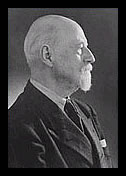Biography
“Colours are the soul of nature and the entire cosmos – and we become part of that soul when we live with the colours”. Rudolf Steiner
Arild Rosenkrantz was born in Denmark on 9 April, 1870. He lived and worked abroad most of his life, mainly in England. From his early years he was influenced by the French salon painters, the Pre-Raphaelites, William Blake and J.M.W. Turner - and later by Claude Monet.
Arild Rosenkrantz's father, the Danish diplomat Baron Iver Holger Rosenkrantz, died before Arild was three years old, so he became closely attached to his Scottish-born mother, Julia Louise Mackenzie, and often accompanied her on her travels to relatives in England, Scotland and Italy.
At sixteen he was sent to Rome to study with Modesto Faustini, the fresco-painter, and two years later he continued his studies at L'Academie Julian in Paris. After her husband's death, his mother developed an interest in spiritualism, and in 1891, when she moved to Rome permanently, she became a spiritualist medium.
During his years in Paris, Rosenkrantz exhibited at the mystic Sar Peladan's "Salon de la Rose+Croix" in 1892-94. He also showed paintings in Copenhagen and London. In 1894 and again in 1895 he travelled to New York where he started working with stained glass. One of his best known windows, the large East window at St Andrew's, Wickhambreaux in Kent, was made in the New York studio of John la Farge, the American inventor of opalescent glass. In 1898 Rosenkrantz moved to London and in 1901 he married his Scottish cousin Louise Augusta (Tessa) Mackenzie.
In London he quickly established himself as a portrait painter and decorative artist. Among his works were the portrait of his cousin The Duchess of Grafton (1905), the symbolist paintings Cupid and Psyche (1896), The Tempter (1896) and The Omnipresent (1907). All these now hang in Rosenholm Castle in Denmark www.rosenholmslot.dk .
During his years in England he had many decorative assignments, including stained glass windows in castles, houses and churches. He did a series of 37 macabre illustrations for a Danish edition of “Tales of Mystery and Adventure” by Edgar Allan Poe.They were exhibited in London in 1909. In 1918 he sculpted a bronze Christ figure for St George's Camberwell in London.
Rosenkrantz joined the Anthroposophic Society in London. Having met Rudolf Steiner there in 1912, he and his wife were asked to join the group of artists in Dornach, Switzerland, who were working with Steiner on decorating the two cupolas in the first Goetheanum – www.goetheanum.ch .
Here Steiner introduced him to Goethe's theory of colour, and this completely changed his whole outlook and way of using colours.
After Steiner's death in 1925 Rosenkrantz and his wife moved back to London where he worked as a teacher, decorated two anthroposophic theatres, designed costumes and stage decorations for them, and held annual exhibitions.
In 1939 the couple travelled to Denmark to visit family and friends and prepare for an exhibition of his paintings on his 70th birthday, April 9, 1940 – the very day the Germans occupied Denmark. This made it impossible for them to return to their home in London, so the owners of Rosenholm, the old family estate in Jutland, invited them to make their home in the castle.
When his wife died there in 1944, the ageing artist gave up the idea of returning alone to England. He spent 20 more very active years in Denmark, painting, lecturing and exhibiting.
The colourful pastels and oils which now hang in the castle are only a part of the large number of paintings that became the result of Rosenkrantz's encounter with Rudolf Steiner and anthroposophy and working with Goethe's theory.
Rosenkrantz felt he had a mission in carrying out Steiner's ideas of using the spectral colours in order to reach the invisible spiritual reality which lies behind the material, and it was his wish that as many as possible should be able to experience this. He painted many versions of the motifs he found especially important, such as Golgotha , The Last Supper , The Hierophant , Madonna , Michael , Wisdom , The Messenger , and the series of four pictures from the Creation: The Mineral World , The Plant World , The Animal World and Man – and The Seven Apocalyptic Seals .
Arild Rosenkrantz died in September 1964. In gratitude for the home he and his wife had been given at Rosenholm, he donated a large number of paintings to the castle, where they can be seen during the summer school holidays.
